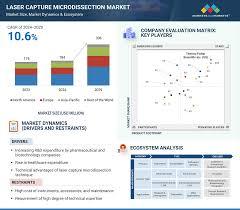The report “Laser Capture Microdissection Market by Product (Instruments, Consumables, Software, Services), System Type (Ultraviolet, Infrared, Immunofluorescence), Application (R&D (Molecular Biology, Cell Biology, Forensics), Diagnostics) – Global Forecast to 2029″, is projected to reach USD 306 million by 2029 from USD 184 million in 2024, at a CAGR of 10.6% during the forecast period of 2024 to 2029. The growth of this market is driven by increasing demand of laser capture microdissection in cancer research, collaborations between academic institutions, research organizations, and industry players to develop innovative LCM technologies. Additionally, continuous advancements in laser technology, microscopy, and automation have led to improved precision, efficiency, and ease of use of LCM systems.

Browse 139 market data Tables and 40 Figures spread through 193 Pages and in-depth TOC on “Laser Capture Microdissection Market by Product (Instruments, Consumables, Software, Services), System Type (Ultraviolet, Infrared, Immunofluorescence), Application (R&D (Molecular Biology, Cell Biology, Forensics), Diagnostics) – Global Forecast to 2029”
View detailed Table of Content here – https://www.marketsandmarkets.com/Market-Reports/laser-capture-microdissection-market-140404059.html
The consumables segment accounted for the largest share, by product in the laser capture microdissection market in 2023.
By product, the laser capture microdissection market has been further categorized as instruments, consumables, software and services. The consumables segment held the largest share of the global laser capture microdissection market in 2023. This can be attributed to increasing adoption of LCM technology across various research fields, advancements in sample preparation techniques, and the rising demand for personalized medicine. Furthermore, support from government agencies and funding organizations for research initiatives in areas such as cancer, neuroscience, and precision medicine provides financial resources for the procurement of LCM consumables. Government funding drives research activities and accelerates the adoption of LCM technology, thereby stimulating the demand for consumables.
The research and development segment accounted for the largest share of the application segment in the laser capture microdissection market in 2023.
Based on application, the global laser capture microdissection market has been segmented into research & development, diagnostics, and other applications. The research & development segment held the largest market share in 2023. The large share of this segment can be attributed to the use of laser capture microdissection for gene expression analysis has lent itself to a diverse set of research areas and applications, including cancer biology, cell biology, neurobiology, pathology, neuroscience, and developmental biology.
The North America region catered the largest share of the laser capture microdissection market in 2023.
The laser capture microdissection market in North America has experienced significant growth in recent years, showcasing a robust expansion trajectory, owing to large pharmaceutical & biopharmaceutical industry in the region, the rising R&D expenditure, stringent regulations, and the presence of major providers of laser capture microdissection products in the US and Canada. Additionally, growth of the North American laser capture microdissection market is driven by significant factors such as a multitude of ongoing cancer research and clinical trials, the expansion of the biosimilars and generics sector, and the increasing adoption of outsourcing preclinical, clinical, and laboratory testing services by pharmaceutical and biopharmaceutical companies.
Key players in the laser capture microdissection market include Thermo Fisher Scientific Inc. (US), Danaher Corporation (US), Carl Zeiss AG (Germany), F. Hoffmann-La Roche AG (Switzerland), Standard BioTools (US), JSR Corporation (Japan), Bio-Rad Laboratories, Inc. (US), Agilent Technologies, Inc. (US), Bruker (US), Molecular Machines & Industries GmbH (Germany), Ocimum Biosolutions (US), Theralink Technologies, Inc. (US), 3DHISTECH, Ltd. (Hungary), Creative Biolabs (US), DeNova Sciences (Singapore), Laxco, Inc. (US), CaresBio Laboratory LLC (US), VitroVivo Biotech (US), AnaPath Services GmbH (Switzerland), Gnome Diagnostics & Gnome Sciences (US), Monasterium Laboratory (Germany), Independent Forensics (US), Norgen Biotek Corp. (Canada), Creative Bioarray (US), and Epistem Ltd. (UK).